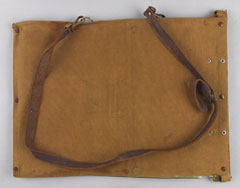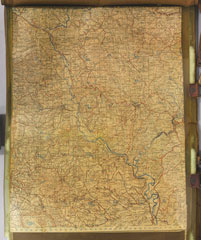
Online Collection
« Prev - 1 of 1 results - Next »
Map case used by Brigadier (later Major General) Joseph Charles Haydon CB, DSO, OBE (1899-1970) while serving as commander of 1st Guards Brigade in Italy, 1944
Joseph Haydon was born in 1899 and joined the Irish Guards in 1917. He was posted to the 2nd Battalion on the Western Front on 10 April 1918, just as the First World War (1914-1918) was reaching its bloody climax. Here he distinguished himself in action and was twice mentioned in dispatches.
On the outbreak of the Second World War (1939-1945) Haydon was a Lieutenant Colonel and was now in command of the 2nd Battalion, which he led with great skill during the campaign in France of May 1940. This notably included operations in the Hook of Holland and mounting a resolute defence of Boulogne against superior enemy forces, for which he was awarded the Distinguished Service Order (DSO).
In October 1940 Haydon was appointed commander of the newly-formed Special Service Brigade. This comprised highly trained commando units, whose role was to carry out hit and run amphibious raids on enemy occupied coastlines.
During his tenure of command Haydon notably led commando raids on Norway in 1941, firstly against the Lofton Islands (Operation Claymore) in February and then against the island of Vaagso (Operation Archery) in December. These raids successfully targeted fish-oil processing facilities and stores, an important ingredient required by the Germans for munitions production. They also brought back a number of enemy prisoners and Norwegian recruits. In addition to this, the Vaagso raid had a far reaching strategic effect, causing the Germans to divert substantial forces to the defence of Norway.
Haydon took command of 1st Guards Brigade on its arrival in Italy in February 1944. The Brigade was immediately deployed against the German's formidable Gustav Line. Here it experienced bitter mountain warfare and the grim battle fought in the rubble of ruined town of Cassino.
Following the Allies' breakout from the Gustav positions in May, the Brigade was incorporated into 6th Armoured Division and formed part of the Allied spearhead which advance northwards in pursuit of the Germans. Haydon remained in command until the end of July. During this time, the Brigade covered over 250 miles in a rapid advance which skirted the city of Rome, saw the breaching of a series of German defensive positions and the capture of a string of towns, including Arce, Perugia and Arezzo. The maps in the case relate to the latter phase of his command as the Brigade advanced north of Rome towards Perugia and Lake Trasimeno.
Italy was to be Haydon's last field command. He went on to serve in a variety of senior staff postings in Washington, Australia and Germany before his retirement in 1951.
NAM Accession Number
NAM. 2005-01-7-1
Copyright/Ownership
National Army Museum, Out of Copyright
Location
National Army Museum, Study collection
Object URL
https://collection.nam.ac.uk/detail.php?acc=2005-01-7-1




